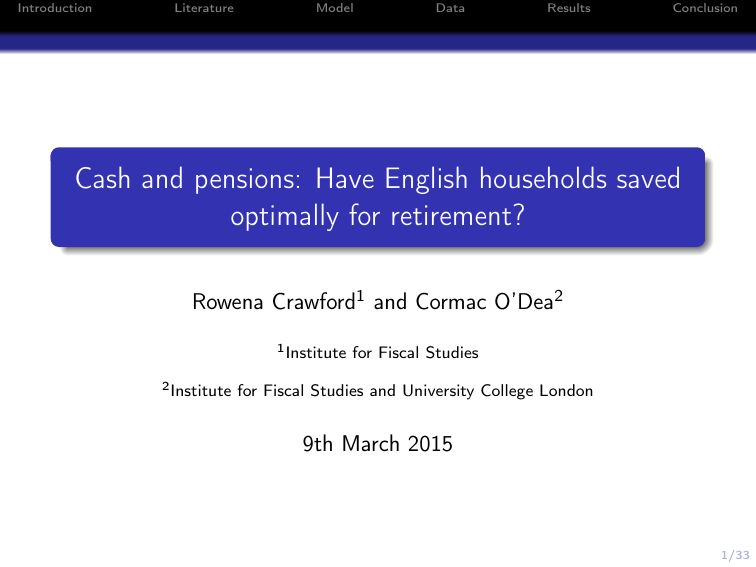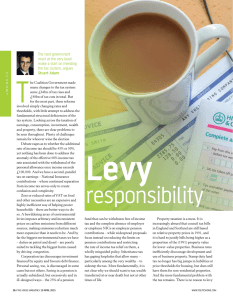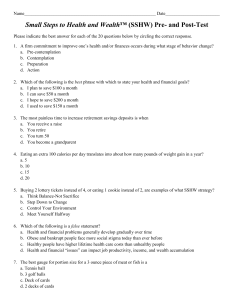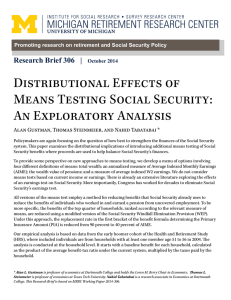Cash and pensions: Have English households saved optimally for retirement? Rowena Crawford
advertisement

Introduction Literature Model Data Results Conclusion Cash and pensions: Have English households saved optimally for retirement? Rowena Crawford1 and Cormac O’Dea2 1 Institute 2 Institute for Fiscal Studies for Fiscal Studies and University College London 9th March 2015 1/33 Introduction Literature Model Data Results Conclusion Outline for section 1 1 Introduction 2 Literature 3 Model 4 Data 5 Results 6 Conclusion 2/33 Introduction Literature Model Data Results Conclusion Introduction I Strong and robust feeling among policymakers that there is undersaving for retirement in the UK (and elsewhere) I This is despite very large stocks of wealth held in the form of private pensions I This paper assesses whether a particular cohort of households have undersaved for retirement We do this using a lifecycle model in which households have access to: I I I I State provided pensions Private non-pension saving Private pension saving 3/33 Introduction Literature Model Data Results Conclusion Introduction I Strong and robust feeling among policymakers that there is undersaving for retirement in the UK (and elsewhere) I This is despite very large stocks of wealth held in the form of private pensions I This paper assesses whether a particular cohort of households have undersaved for retirement We do this using a lifecycle model in which households have access to: I I I I State provided pensions Private non-pension saving Private pension saving 3/33 Introduction Literature Model Data Results Conclusion Introduction I Strong and robust feeling among policymakers that there is undersaving for retirement in the UK (and elsewhere) I This is despite very large stocks of wealth held in the form of private pensions I This paper assesses whether a particular cohort of households have undersaved for retirement We do this using a lifecycle model in which households have access to: I I I I State provided pensions Private non-pension saving Private pension saving 3/33 Introduction Literature Model Data Results Conclusion State pensions in the US and UK 4/33 Introduction Literature Model Data Results Conclusion State pensions in the US and UK 5/33 Introduction Literature Model Data Results Conclusion Summary of results from this paper 6/33 Introduction Literature Model Data Results Conclusion Summary of results from this paper 7/33 Introduction Literature Model Data Results Conclusion Outline for section 2 1 Introduction 2 Literature 3 Model 4 Data 5 Results 6 Conclusion 8/33 Introduction Literature Model Data Results Conclusion Literature I Analysis of replacement rates I I I Consumption changes around retirement I I US: Munnell et al. (2007, 2012) UK: Banks et al. (2005), Crawford & O’Dea (2012) Banks et al. (1998), Bernheim et al. (2001), Battistin et al. (2008) Issue relevant to many structural papers - ours is most closely related to: I Scholz et al. (2005), Gustman & Steinmeier (2006) 9/33 Introduction Literature Model Data Results Conclusion Literature I Analysis of replacement rates I I I Consumption changes around retirement I I US: Munnell et al. (2007, 2012) UK: Banks et al. (2005), Crawford & O’Dea (2012) Banks et al. (1998), Bernheim et al. (2001), Battistin et al. (2008) Issue relevant to many structural papers - ours is most closely related to: I Scholz et al. (2005), Gustman & Steinmeier (2006) 9/33 Introduction Literature Model Data Results Conclusion Literature I Analysis of replacement rates I I I Consumption changes around retirement I I US: Munnell et al. (2007, 2012) UK: Banks et al. (2005), Crawford & O’Dea (2012) Banks et al. (1998), Bernheim et al. (2001), Battistin et al. (2008) Issue relevant to many structural papers - ours is most closely related to: I Scholz et al. (2005), Gustman & Steinmeier (2006) 9/33 Introduction Literature Model Data Results Conclusion Outline for section 3 1 Introduction 2 Literature 3 Model 4 Data 5 Results 6 Conclusion 10/33 Introduction Literature Model Data Results Conclusion Utility function Household’s maximise the discounted expected sum of the utility of (equivilised) consumption: ct eq nt U eq nt Utility function is standard constant relative risk aversion function 11/33 Introduction Literature Model Data Results Conclusion Utility function Household’s maximise the discounted expected sum of the utility of (equivilised) consumption: ct eq nt U eq nt Utility function is standard constant relative risk aversion function 11/33 Introduction Literature Model Data Results Conclusion Assets and choice variables In addition to the state pension system, there are two assets: 1. Risk-free asset 2. Defined contribution pension (401k-style) There are two choices to make each period: 1. How much to consume 2. How much to split savings between cash and the pension 12/33 Introduction Literature Model Data Results Conclusion Assets and choice variables In addition to the state pension system, there are two assets: 1. Risk-free asset 2. Defined contribution pension (401k-style) There are two choices to make each period: 1. How much to consume 2. How much to split savings between cash and the pension 12/33 Introduction Literature Model Data Results Conclusion Uncertainty There is uncertainty over: I Employment I Wages I Return on private pension I Survival 13/33 Introduction Literature Model Data Results Conclusion Wages and employment I Wages: I I Household log wages for each of three education types ed are the sum of a fixed effect, a quadratic in age and an persistent stochastic component lnẽit = αi + β1ed ageit + β2ed ageit2 + uit uit = ξ ∼ ρed uit−1 + ξit 2 N 0, σed Employment occurs with probability π in each period: eit = e˜it 0 w .p. πed w .p. 1 − πed Heterogeneity 14/33 Introduction Literature Model Data Results Conclusion Wages and employment I Wages: I I Household log wages for each of three education types ed are the sum of a fixed effect, a quadratic in age and an persistent stochastic component lnẽit = αi + β1ed ageit + β2ed ageit2 + uit uit = ξ ∼ ρed uit−1 + ξit 2 N 0, σed Employment occurs with probability π in each period: eit = e˜it 0 w .p. πed w .p. 1 − πed Heterogeneity 14/33 Introduction Literature Model Data Results Conclusion Retirement I I Household retirement happens when the male reaches 65 Retirement involves stopping work and drawing down DC pension I I 25% of the pension in a tax free lump sum 75% is annuitised at rates that are actuarially fair after a deduction for administrative costs 15/33 Introduction Literature Model Data Results Conclusion ‘Optimal consumption’ Optimal consumption allocation satisfies an Euler equation in equivilised consumption: ct 0 0 ct+1 U = β(1 + r )E U nteq nteq 1 We set β = 1+r such that households are no more impatient than they are compensated for in the return on risk-free saving: ct 0 ct+1 0 =E U U nteq nteq Recursive 16/33 Introduction Literature Model Data Results Conclusion ‘Optimal consumption’ Optimal consumption allocation satisfies an Euler equation in equivilised consumption: ct 0 0 ct+1 U = β(1 + r )E U nteq nteq 1 We set β = 1+r such that households are no more impatient than they are compensated for in the return on risk-free saving: ct 0 ct+1 0 =E U U nteq nteq Recursive 16/33 Introduction Literature Model Data Results Conclusion Outline for section 4 1 Introduction 2 Literature 3 Model 4 Data 5 Results 6 Conclusion 17/33 Introduction Literature Model Data Results Conclusion Data Data source is English Longitudinal Study of Ageing (ELSA) linked with administrative data on National Insurance contributions I English Longitudinal Study of Ageing I I I I Interviewed every 2 years Careful measurement of wealth (including pension wealth) Similar in form and purpose to HRS (USA) and SHARE (Europe) National Insurance (Social Security) contributions I I Respondents were asked for permission to link their survey data to NI records Allows us obtain earnings histories (subject to some censoring) More 18/33 Introduction Literature Model Data Results Conclusion Data Data source is English Longitudinal Study of Ageing (ELSA) linked with administrative data on National Insurance contributions I English Longitudinal Study of Ageing I I I I Interviewed every 2 years Careful measurement of wealth (including pension wealth) Similar in form and purpose to HRS (USA) and SHARE (Europe) National Insurance (Social Security) contributions I I Respondents were asked for permission to link their survey data to NI records Allows us obtain earnings histories (subject to some censoring) More 18/33 Introduction Literature Model Data Results Conclusion Sample Sample is: I Couples I Man born in the 1940s I Where we have NI records for both members of the couple 19/33 Introduction Literature Model Data Results Conclusion Parameterisation Parameter Unemployment rate Return on safe asset Mean pension return St. Dev. pension return Survival probabilities Administrative load on annuities Discount factor Coefficient of relative risk aversion Equivalence scale Symbol π r φ̄ σ¯φ stm , stf q β γ n Value/Source 6.2% 2.2% 4.0% 13.8% ONS Life Tables 10% 1 1+r = 0.978 1.5 Modified OECD scale 20/33 Introduction Literature Model Data Results Conclusion Outline for section 5 1 Introduction 2 Literature 3 Model 4 Data 5 Results 6 Conclusion 21/33 Introduction Literature Model Data Results Conclusion Summary of results from this paper Sensitivity By Quintile 22/33 Introduction Literature Model Data Results Conclusion Results - excluding housing 23/33 Introduction Literature Model Data Results Conclusion Results - excluding housing Baseline model: Excluding housing: Proportion undersaving: 7.9% R-squared: 0.31 Proportion undersaving: 25.1% R-squared: 0.32 24/33 Introduction Literature Model Data Results Conclusion Building in (exogenous) housing wealth accumulation We add to the baeline model: I an exogenous consumption flow coming from holding housing wealth (r h Ht ) I a deduction for mortgage payments (ht ) from available resources Adapted Baseline C C eq eq h u(c) = nt U eq u(c) = nt U eq +r Ht nt nt at+1 = 1+r at +yt −ct −pt at+1 = 1+r at +yt −ct −pt −ht More 25/33 Introduction Literature Model Data Results Conclusion Building in (exogenous) housing wealth accumulation We add to the baeline model: I an exogenous consumption flow coming from holding housing wealth (r h Ht ) I a deduction for mortgage payments (ht ) from available resources Adapted Baseline C C eq eq h u(c) = nt U eq u(c) = nt U eq +r Ht nt nt at+1 = 1+r at +yt −ct −pt at+1 = 1+r at +yt −ct −pt −ht More 25/33 Introduction Literature Model Data Results Conclusion Results - exogenous housing Baseline model: Exogenous housing: Proportion undersaving: 7.9% R-squared: 0.31 Proportion undersaving: 16.0% R-squared: 0.24 26/33 Introduction Literature Model Data Results Conclusion Discussion What’s missing from the model? I Non-separabilities between consumption and leisure I Home production I Nursing home expenses I Bequest motives 27/33 Introduction Literature Model Data Results Conclusion Replacement rates Proportion of couples with retirement income replacing less than X % of average real (gross) earnings between the age of 20 and 50: Replacement Rate Income coming from ... Pensions Annuitised Annuitised non-housing housing wealth wealth <=67% <=80% <=100% >100% 28/33 Introduction Literature Model Data Results Conclusion Replacement rates Proportion of couples with retirement income replacing less than X % of average real (gross) earnings between the age of 20 and 50: Replacement Rate <=67% <=80% <=100% >100% Income coming from ... Pensions Annuitised Annuitised non-housing housing wealth wealth 19.6 35.0 58.6 41.4 29/33 Introduction Literature Model Data Results Conclusion Replacement rates Proportion of couples with retirement income replacing less than X % of average real (gross) earnings between the age of 20 and 50: Replacement Rate <=67% <=80% <=100% >100% Income coming from ... Pensions Annuitised Annuitised non-housing housing wealth wealth 19.6 10.0 35.0 19.9 58.6 41.0 41.4 59.0 30/33 Introduction Literature Model Data Results Conclusion Replacement rates Proportion of couples with retirement income replacing less than X % of average real (gross) earnings between the age of 20 and 50: Replacement Rate <=67% <=80% <=100% >100% Income coming from ... Pensions Annuitised Annuitised non-housing housing wealth wealth 19.6 10.0 2.3 35.0 19.9 5.3 58.6 41.0 16.0 41.4 59.0 84.0 31/33 Introduction Literature Model Data Results Conclusion Outline for section 6 1 Introduction 2 Literature 3 Model 4 Data 5 Results 6 Conclusion 32/33 Introduction Literature Model Data Results Conclusion Conclusions I 9 out of every 10 of those born in the 1940s have more than enough wealth to maintain living standards into retirement I New concern is that younger cohorts are undersaving for retirement I Maybe not such a concern if their parents have ‘oversaved’ ? I New work planned on younger cohorts with the Wealth and Assets Survey 33/33 Extra slides Outline for section 7 7 Extra slides 34/33 Extra slides Heterogeneity The problem solved (and therefore the decision rules obtained) are different for each household in the sample in three dimensions 1. Their earnings process (fixed effect) 2. The number and timing of children 3. State pension entitlements Back 35/33 Extra slides Optimal wealth and the proportion undersaving All Median optimal wealth 77 Prop. undersaving 7.9% Median deficit (cond.) 39 Median surplus (cond.) 226 Median observed wealth 324 L.E. Quint 1 2 3 4 5 36/33 Extra slides Optimal wealth and the proportion undersaving All L.E. Quint 1 2 3 4 5 Median optimal wealth 77 Prop. undersaving 7.9% Median deficit (cond.) 39 Median surplus (cond.) 226 Median observed wealth 324 0.6 29 73 152 392 9.5% 4.5% 6.5% 8.5% 10.6% 8 11 28 79 94 126 189 232 283 329 119 213 293 392 690 Back 37/33 Extra slides Recursive formulation Value function and consumer problem: Z m f Vt (Xt ) = max U(ct ) + βst+1 st+1 Vt+1 (Xt+1 , h = 1)dF (Xt+1 |Xt ) ct ,dct Z m f + βst+1 (1 − st+1 ) Vt+1 (Xt+1 , h = 2)dF (Xt+1 |Xt ) Z m f + β(1 − st+1 )(st+1 ) Vt+1 (Xt+1 , h = 3)dF (Xt+1 |Xt ) Xt contains 6 state variables: I Age; Wages; HH composition; Cash; DC wealth; Pension Income Back 38/33 Extra slides Intertemporal budget constraints I Cash: at+1 = 1 + r at + yt − ct − dct Household income yt is given by: yt = τ (e, ra, pp, sp, h, k, dc, t) I DC wealth DCt+1 = (1 + φt DCt + dct ) φ ∼ N φ̄, σφ2 Back 39/33 Extra slides Defined Benefit Pensions Many in this cohort have wealth in older-style ‘Defined Benefit’ pensions I Model does not contain DB pensions I The question we are asking is what would these households had saved if given access only to the DC fund I Much of observed wealth will have come from remittances by employers, not employees I We augment household earnings to take account of this More 40/33 Extra slides Summary statistics on wealth Mean wealth holdings: Total net wealth of which: Financial Prim. hous. Other hous. Physical Priv. pen. State pen. Sample size Mean £ % 574,048 100 52,514 147,431 23,589 40,962 187,281 122,271 996 9.1 25.7 4.1 7.1 32.6 21.3 Back 41/33 Extra slides Table: State pension wealth, lifetime earnings, and implied average lifetime savings rates, by quintile of lifetime earnings All Quintile 1 (Lowest) 2 3 4 5 (Highest) Mean state pension wealth 122 Mean lifetime earnings 1,090 Mean priv. wealth / life. earn. 13.5% Mean (priv + state wealth) / life. earn. 24.7% 108 123 124 129 127 483 793 970 1,219 1,988 2.0% 4.9% 8.5% 13.8% 22.0% 24.3% 20.4% 21.3% 24.4% 28.4% 42/33 Extra slides Housing I Cost (ht ): I I I I I Yield (r h ) I I Households are assumed to only have owned their current property They are assumed to have saved 1.5% of the purchase value from the age of 20 to the year of purchase They take out a 25 year mortgage for the purchase price less the value of their deposit Time series of mortgage interest rates taken from Bank of England r h = 4.4% (Bank of England (2007)) House value (Ht ) I I I Property value known at purchase and at survey date Assumed to have grown at a constant rate between purchase date and survey date Assumed to grow at the rate of return on riskless asset in the future (after the last survey) 43/33 Extra slides Sensitivity Baseline Early ret γ=3 β=1 Comp to age 64 1 asset Median optimal wealth 77 81 75 301 154 53 Prop. undersaving 7.9% 10.2% 8.2% 42.9% 28.8% 4.5% Median deficit (cond.) 39 58 34 94 105 11 Median surplus (cond.) 226 208 223 138 191 273 R squared 0.31 0.28 0.30 0.38 0.19 0.26 Back 44/33 Extra slides Administrative data Our administrative data gives us: I Exact earnings 1997-2004 I Topcoded earnings 1975-1996 (top-coding affects 7.4% of year-individual observations) I Number of weeks work prior to 1975 We impute data over the censoring point using a fixed-effects Tobit I Biased I Though Greene (2004) finds bias is minimal in panels even much shorter than ours (T = 29) I Plot of quantiles before and after 1997 show only small discontinuities 45/33 Extra slides Quantiles of earnings process Figure: Selected quantiles of earnings Back 46/33 Extra slides Model solution Solution is by backwards recursion from a final period where the decision rules and value function are known Further details: I Earnings, assets, stocks of DC assets and pension income are placed on a grid I Integration is by quadrature I Optimisation is by golden section search Back 47/33 Extra slides Components of the tax and benefit system The tax and benefit function contains: I Income tax I National insurance I Job-seekers allowance I Child benefit I Means-tested support in retirement Back 48/33 Extra slides Accounting for employer pension contributions We inflate upwards our earnings data etd by a proportion x: x= PS−1 t κPS Q etd ( St (1+φt )) where: I κ is the proportion of earnings that the employer remits to the pension fund I Ps is the pension wealth observed in survey period S I φt is the return on DC funds in the year the particular household is of age t Back 49/33 Extra slides Estimates of earnings process parameters ρ σξ2 2 σm Education group Low Middle High 0.8468 0.9727 0.9527 (0.0838) (0.0153) (0.0025) 0.0413 0.0417 0.0422 (0.0026) (0.0033) (0.0026) 0.0024 0.0029 0.0066 (0.0021) (0.0026) (0.0016) 50/33 Extra slides Results - ‘optimal’ replacement rates Implied replacement rates of average lifetime earnings (between 20 and 50): 51/33







